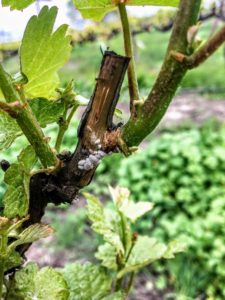Growing Together Spring 2021
Vigilance is Key to Combatting Vine Mealybug and Leafroll 3 in the Region

Plant viruses are nothing new to the agriculture industry, but how we successfully address disease presence and pressure and assess how they impact other operational needs requires proactive management. For example, Leafroll 3 is a devastating virus found more recently in vineyards in our region. Leafroll 3 virus can decrease yields, cause poor fruit quality and color, delay fruit ripening, lower Brix and decrease a vineyard’s lifespan.
What causes Leafroll 3?
The virus is transferred through a vector, in this case Vine Mealybugs which can transmit the virus from vine to vine and vineyard to vineyard. Since Vine Mealybugs reproduce at a very fast rate, have the ability to travel far distances and can survive harsh winters, the combination of Vine Mealybugs (VMB) and Leafroll 3 can be uncontrollable. Together, they have recently proven to be a significant contributor to sudden vine collapse or in the worst case lead to entire vineyards dying off. In the 1990s and early 2000s, Leafroll 3 was not a significant problem, on a broadscale, in California because it was largely only spread through cuttings and grafting. It was a threat to the vineyard infected, but not to the widespread neighboring community.
With the introduction of Vine Mealybugs as a resilient vector, Leafroll 3 took the virus into an “aerial” spread with the ability to be transmitted not by direct contact such as grafting or cutting, but rather through travel of insect from field to field. In recent years, the warmer and longer fall seasons have allowed Vine Mealybugs to have more reproduction generations per season. This ultimately contributes to higher populations, feeding on more plants and increasing the chances of vectoring Leafroll 3. The specific regions of San Joaquin Delta, Central Valley and coastal counties have been vastly impacted.
How can this virus be managed?
Currently, there is no registered product on the market proven to suppress the uncontrollable damages of Leafroll 3 once a vine is infected. However, there are management practices we can move towards to suppress the prevalence of the virus across our viticultural community. One significant step that can be taken to reduce the risk is to aggressively control Vine Mealybugs in vineyards. To date, we know that we can control the cosmetic and quality effects from the Vine Mealybug population in a vineyard with conventional tools to ensure a satisfactory crop each year. However, to combat this problem more directly, we need to not only suppress the Vine Mealybug population but eliminate them as much as possible
Instead of viewing Vine Mealybugs as a threat to your vineyard yield this year, we must view them as a long-term threat to the whole vineyard. All it takes is one Vine Mealybug to transmit the virus from one vine to the next, and gradually infect the entire vineyard. In addition to managing Vine Mealybug, it is important for growers to remove Leafroll 3-infected vines if at all possible. If there are no Leafroll 3-infected vines in a vineyard or within a 100-mile radius, then Vine Mealybugs can feed on vines but never transmit the virus.
Combatting Vine Mealybugs and Leafroll 3 as a community.
When dealing with viruses that can easily spread, it is important to keep in mind that your farming practices do not only affect your vineyards. Vine Mealybugs can move through the air up to half of a mile and can carry the virus with them. Understanding how your practices can impact your neighbor and how the virus can transfer will help mitigate the chances of spreading the virus from vineyard to vineyard. We have seen that this virus is here in our local regions and therefore, we need to join as a community to combat this virus as a community of growers. The more information we can gather and share amongst our community will help in reducing the spread of the virus and suppressing it in the areas where it is currently. As part of this community, we must stand together to continue to work towards mitigation.
To get started on your management plan for mitigation, we recommend consulting your PCA. The current risks of Vine Mealybug and Leafroll 3 can have on the long-term health of your vineyard and investment are only growing.
We would like to thank Aaron Lange from LangeTwins Family Winery and Vineyards for taking the time to provide us grower insights. Aaron, along with a community of growers, viticulturists, and the Lodi Winegrape Commission has been working together to combat the spread of Vine Mealybugs and Leafroll 3.
